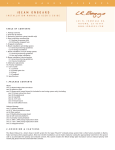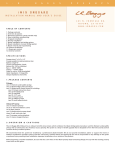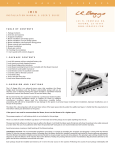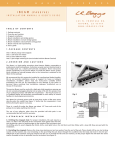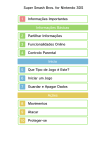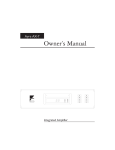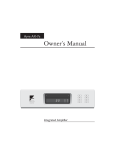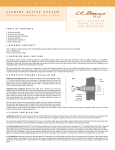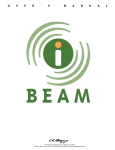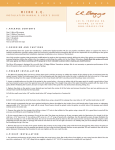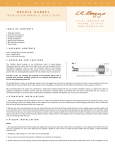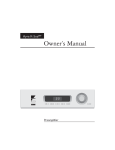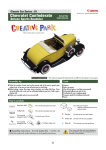Download L.R. Baggs iBeam Onboard-Sm: Installation Manual & User's Guide
Transcript
L . R . i B E A M INSTALLATION B A G G S P I C K U P S O N B O A R D -S m MANUAL & USER'S GUIDE 4 8 3 N . F R O N T A G E N I P O M O , C A R D . 9 3 4 4 4 W W W . L R B A G G S . C O M TA B L E O F CO N T E N TS 1. Package contents 2. Overview & cautions 3. Removal of previous system (retrofit only) 4. New installation woodworking 4.1. Routing the preamp hole 4.2. Drilling the strapjack hole 5. Strapjack installation 6. iBeam installation: pin bridge guitars 6.1. General positioning guidelines 6.2. Pin bridge installation 7. iBeam installation: non-pin bridge guitars 7.1. General positioning guidelines 7.2. Non-pin bridge installation 8. iBeam installation: classical guitars 8.1. General positioning guidelines 8.2. Classical installation 9. Alternative placements 10. Preamp installation 11. Controls 12. Specifications 1.PACK AGE CONTENTS iBeam: one (1) iBeam bridge plate transducer two (2) adhesive strips one (1) iBeam quick mount fixture kit (included in steel string system only), including: one (1) fixture instruction sheet two (2) threaded posts two (2) standoffs two (2) .312" nuts one (1) fixture board two (2) small adhesive dots Onboard Preamp: one (1) onboard preamp six (6) ½" black installation screws six (6) fiber washers one (1) flexible black preamp bezel two (2) self-stick wire platforms one (1) preamp routing template one (1) .090" x .048" pickup replacement shim one (1) .120" x .048" pickup replacement shim one (1) strapjack harness 2 . OVE RVI E W & C AUT IONS The iBeam Onboard-Sm is a direct drop-in retrofit system for the smaller “Brand X” onboard pickup system that is often factory-installed on Martin, Taylor and many other popular guitars. New (non-retrofit) installations can be made simply by routing the appropriately-sized hole in the guitar’s side to accommodate the preamp and onboard controls. This system includes the iBeam bridge plate transducer and an onboard preamp with volume, EQ and notch filter controls. We recommend that this system be installed by a professional dealer/installer. We do not provide installation advice or support for home or hobbyist installations. Installers: please read the instructions carefully before proceeding. We will not be responsible for any damage to the guitar or personal injury resulting from installation, improper installation, use or misuse of the product. fig. 1 Before beginning, be sure that the screw holes in the iBeam preamp bezel (mounting flange) line up with the “Brand X” preamp screw holes on the guitar. There are two versions of this system (steel string and classical), each with its own pickup installation procedure. Before beginning, confirm that there is enough room between the bracing to install the pickup. The steel string iBeam fits x-braced guitars with at least 3 inches of flat open space directly under the saddle (see figure 1). The classical iBeam fits most Torres-fan-braced guitars with at least 3 inches of clean, flat area between the two braces on either side of the center brace under the bridge (see figure 2). fig. 2 The preamp will only fit in guitars with a clearance of at least 2 3/16” between the top and back braces, at the point where the preamp chassis hangs inside the instrument. Again, verify that these requirements are met before making any alterations to the guitar. If the space is too small to accommodate the iBeam, do not cut the iBeam to fit a tighter space. The steel and nylon string preamps are voiced for their respective pickups, and each will only work in the type of guitar for which it is intended. The mounting fixture included in the steel string system will work with pin bridge guitars only. If you have a non-pin bridge steel string guitar, see the non-pin bridge installation section (section 7). The preamp requires a 9V battery, which is not included in this package. There is a small slit under the iBeam cap about 1/2" from each end of the pickup. Do not poke anything into the slit. The peel-and-stick adhesive is the best way to adhere the iBeam. It will hold the iBeam quite firmly, yet it is possible to remove it at a later time. The use of any adhesive other than the provided self-stick pads is not recommended and will void the warranty. 3.R E MOVAL OF PRE VI O US S Y S T E M (retrofit installations only) Remove the entire preamp, output harness and pickup. Two precision mahogany wood shims have been provided to replace the installed undersaddle pickup. Choose the correct one to fit your saddle width, and trim to length. You will also need to remove the old strapjack. Most guitar manufacturers include cross-grain reinforcement panels on solid wood guitars beneath the preamp mounting screw holes. If, upon removing the old preamp from a solid wood guitar, you discover that there are no reinforcement strips, we recommend installing cross-grain reinforcement shims underneath the screw holes to prevent chipping the wood on the guitar body. Once the previous system is removed, proceed to the strapjack installation instructions in section 5. 4.N E W I N STALL AT I ON WOO DWO RK IN G 4.1 Routing the Preamp Hole: The preamp will only fit in guitars with a clearance of at least 2 3/16” (61.9mm) between the top and back braces, at the point where the preamp chassis hangs inside the instrument. For solid wood guitars (especially maple), we recommend gluing two 2.5” (63.5 mm) x .5” (12.7 mm) plywood cross-grain reinforcement panels on the inside of the guitar body where each screw hole will be drilled. This prevents the wood from splitting during the drilling process. If you are uncomfortable freehand-cutting this area using the enclosed paper template (as described below), we recommend that you use the paper template to fashion a hard template out of masonite or Plexiglas or other suitable material. 1. Choose a location on the side of the instrument to mount the preamp. The flattest possible area just above the waist on the upper bout and below the shoulder is recommended. Double-check to make sure the preamp will clear all internal braces and other obstacles when installed. 2. Lay the enclosed paper template on the chosen location and secure it with masking tape on all four edges. With a sharp scribe put a dimple in the center of each of the screw holes and then drill out the holes using a #45 drill bit (.082”/2.08 mm). Cut out the area for the preamp carefully and slowly using a rotary cutter with a sharp 1/8” cutting bit. We recommend cutting just inside the lines for the initial cut and then cleaning up the edges with a file. Remove the template and clean up any excess tape residue with a soft cloth and naphtha. 4.2 Drilling the strapjack hole: For proper installation, this jack requires a clean 1/2" hole in the tail block of the instrument. Start by placing a piece of masking tape on the outside of theinstrument over the drilling area (to avoid chipping the finish), drill a small pilot hole in the tail block and then follow with a step drill. Now proceed to the strapjack installation as detailed in the following section. fig. 3 tail block smaller threaded section protrudes 5.S T R APJAC K INSTALL ATIO N Remove the strap ring, retaining nut and one washer from the end of the jack. There should still be one star locking washer, one flat washer and a nut remaining on the jack. Bring the jack down through the soundhole into the body and insert it into the pre-drilled hole in the tail block. Using the internal nut (be sure to include the flat and star washer), set the proper depth that will allow the entire smaller threaded section to protrude from the instrument (see figure 3). With the jack in place, lay the remaining washers over the threads and attach the external retaining nut until it’s tight. Finish by attaching the strap ring (it should cover the retaining nut and washer) so as not to crack the finish of the instrument by asserting too much pressure. Now proceed to the appropriate iBeam installation instructions (pin bridge, non-pin bridge or classical) in the following sections. 6.iBEAM INSTALL ATION: PIN GUITARS BRIDGE 6.1 General positioning guidelines: The iBeam is a highly sensitive pickup; therefore, placement and the unique characteristics of the instrument are critical factors in producing the outstanding results of which the iBeam is capable. A few millimeters in any direction can have profound effects on the quality of the sound. In short, because each guitar is different, we can tell you approximately where the pickup should be placed, but we can not provide an exact specification. The iBeam is designed to attach to the bridge plate, directly under the saddle line and generally parallel to the saddle, with the attached peel-and-stick adhesive. Good results should be consistently had by attaching the pickup as shown in figure 4. However, because every guitar is unique, you may be rewarded by searching for the optimum location. The optimum location will deliver a sound that is focused and tight, with proper string balance and good presence. It will capture enough of the string resonance to be articulate, but will be mellowed by a full and strong body resonance. Ultimately, it will accurately capture the distinct tone of the instrument. An unsatisfactory location will often be characterized by a woofy or nasal tone, poor string balance and a high sensitivity to feedback. In general, placing the iBeam directly under the saddle will provide the greatest sense of immediacy, impact, snap and “string” sound. Offsetting the pickup either toward the sound hole or toward the bridge pins in the area shown in figure 5 will increase the amount of “body” in the sound and generally have a more mellow and homogeneous sound with less midrange. We have often achieved our very best results by placing the pickup as close to the string ball-ends as is practical and offsetting it about 1 to 2 mm toward the treble side of the saddle. An alternative location that has often worked well, provided the x-braces are wide enough, is to offset the pickup toward the front edge of the bridge plate. Do not test the pickup placement without firmly securing the adhesive. Without completely securing the pickup, the sound test will produce unreliable results. 6.2 Pin bridge installation (initial placement): 1. Assemble the mounting fixture. 2. Remove the strings from the pin holes. 3. Reach inside the hole and feel around under the bridge to be sure the bridge plate is free from debris and obstructions. If you are unsure, stick a mirror inside to inspect this area. 4. Place the stationary rod of the mounting fixture in the high-E bridge pin hole and adjust the movable rod laterally in the slot until it drops into the lowE bridge pin hole as shown in figure 6. Tighten the nut to secure the movable rod. fig. 6 5. Place the adhesive dots on the fixture over the saddle, one on each side of the big slot. Remove the adhesive backing from the dots and position the iBeam over the fixture in the desired location. Stick the iBeam to the adhesive dots on the fixture as shown in figure 7. 6. Remove the fixture and iBeam together from the bridge and remove the adhesive backing from the bottom surface of the iBeam. 7. Insert the fixture holding the iBeam into the guitar. Find the high- and low-E string bridge pin holes with the rods on the fixture. 8. Insert the rods into these holes and then elevate the fixture straight up until the rods just poke out of the holes about 1/2". Grasp one of the rods from the outside of the guitar and hold it. Do not pull up yet. While holding the one rod let go of the fixture inside of the guitar and grab the other rod on the outside of the guitar. fig. 7 9. Now pull straight up on the rods as shown in figure 8 to elevate the iBeam until it contacts the bridge plate. Tug up on the rods to secure the pickup. 10. Pop the fixture off the iBeam inside the guitar and remove the fixture. 11. Press up firmly along the top surface of the iBeam, especially on the ends, to secure it. It’s usually a good idea to press down on the bridge from the outside of the guitar as you press up on the iBeam from the inside to equalize pressure and avoid cracking the top. Wiggle the iBeam front to back a little as you press. 12. Plug in and test the pickup placement. If the sound is satisfactory (see 6.1: general positioning guidelines for a rough definition of this), proceed to the preamp installation instructions (section 10). If the sound is unsatisfactory, we encourage you to experiment with alternative placements (see section 9). 7.iB EAM I NS TALL ATION : NON - PI N B RI DG E GU ITARS fig. 8 7.1 General positioning guidelines: The iBeam is a highly sensitive pickup; therefore, placement and the unique characteristics of the instrument are critical factors in producing the outstanding results of which the iBeam is capable. A few millimeters in any direction can have profound effects on the quality of the sound. Because every guitar is unique, you may be rewarded by searching for the optimum location. In short, because each guitar is different, we can tell you approximately where the pickup should be placed, but we can not provide an exact specification. With non-pin bridge guitars, it is also unlikely that the first selected spot will be ideal. The optimum location will deliver a sound that is focused and tight, with proper string balance and good presence. It will capture enough of the string resonance to be articulate, but will be mellowed by a full and strong body resonance. Ultimately, it will accurately capture the distinct tone of the instrument. An unsatisfactory location will often be characterized by a woofy or nasal tone, poor string balance and a high sensitivity to feedback. In general, placing the iBeam directly under the saddle will provide the greatest sense of immediacy, impact, snap and “string” sound. Offsetting the pickup either toward or away from the sound hole will increase the amount of “body” in the sound and generally have a more mellow and homogeneous sound with less midrange. Do not test the pickup placement without firmly securing the adhesive. Without completely securing the pickup, the sound test will produce unreliable results. 7.2 Non-pin bridge installation (initial placement): Installation on non-pin bridge guitars requires that you remove the saddle, drill a small hole in each end of the saddle slot, and insert guide pins to act as a reference when locating the iBeam. The hole locations will correspond to the small slots in the bottom of each end of the iBeam (see figure 9). A good starting place is to drill the holes so that the iBeam will be centered under the E strings. You will need an inspection light, inspection mirror, drill, 1/16" drill bit, wooden matchsticks or toothpicks, and a short pencil. fig. 9 This top-down view depicts the bridge with the saddle removed. These pin hole locations apply to all steel and nylon string non-pin bridges. saddle slot drill pin hole here iBeam bridge bridge tie block 1. Drill a 1/16" hole through the bridge at both ends of the saddle slot. If the guitar already has a hole in the saddle slot for a pickup, you may be able to use this as one of the holes. The minimum distance between the holes should allow the notches in each end of the iBeam's base to nest over the protruding matches or toothpicks that you will insert as a reference to place the iBeam. 2. Press the matchsticks or toothpicks into the holes until they just protrude (1/16" to 1/8") into the guitar. These will act as locating pins for determining the iBeam's placement. 3. Remove the adhesive backing from the iBeam and, holding the iBeam upright between your thumb and two middle fingers, use your index and little fingers to locate the matches. 4. Hold the iBeam at a slight angle away from the inside of the guitar top, and, using the slot in one end of the bottom of the iBeam, locate one of the protruding matches. Rotate the other end of the pickup until you find the other protruding match with the slot in the other end of the iBeam. Then very lightly press the adhesive against the bridge plate with just enough pressure to hold it in place. 5. Once you have tacked the pickup into place, insert an inspection mirror into the body to check the placement of the pickup. After confirming that it is located correctly, remove the guide pins and press firmly with a little rocking motion over the surface of the top of the pickup to secure it to the bridge plate. Be sure to apply an equal downward force to the top of the bridge when pressing up from the inside to prevent damage to the guitar. 6. Plug in and test the pickup placement. If the sound is satisfactory (see 7.1: general positioning guidelines for a rough definition of this), proceed to the preamp installation instructions (section 10). However, with non-pin bridge guitars, it is likely that the results will be less than optimum at this position. If this is the case, we encourage you to experiment with alternative placements (see section 9). 8. iB EAM INSTALL AT IO N: CL ASSIC AL GU I TARS 8.1 General positioning guidelines: The iBeam is a highly sensitive pickup; therefore, placement is a critical factor in producing the outstanding results of which the iBeam is capable. A few millimeters in any direction can have profound effects on the quality of the sound. In short, because each guitar is different, we can tell you approximately where the pickup should be placed, but we can not provide an exact specification. With classical guitars, it is also unlikely that the first selected spot will be ideal. The classical iBeam has a tunnel in the center of the pickup designed to clear the middle fan brace. The tunnel is wide enough to allow for some lateral movement of the pickup. We suggest that you initially position the pickup so it is laterally centered over the brace and that the entire pickup is offset towards (and parallel to) the tie block by 2 to 5 mm. The idea is to blend the direct string sound with the sound of the body. The more centered the pickup is under the saddle, the more string drive and "snap" the sound will have. Offsetting the pickup towards the tie block or even towards the sound hole by a few millimeters will allow more body sound to mix with the string sound. If you desire more presence from the bass strings and wish to mellow out the high strings, center the pickup under the bass strings and angle it so the center of the pickup's high string end is either in front or behind the saddle line by some amount. The reverse angle will have more presence for the high strings and less for bass. If you find that the small E string does not have enough level, offsetting the pickup laterally towards it will increase its volume (see figure 9). The optimum location will deliver a sound that is focused and tight, with proper string balance and good presence. It will capture enough of the string resonance to be articulate, but will be mellowed by a full and strong body resonance. Ultimately, it will accurately capture the distinct tone of the instrument. An unsatisfactory location will often be characterized by a woofy or nasal tone, poor string balance and a high sensitivity to feedback. Do not test the pickup placement without firmly securing the adhesive. Without completely securing the pickup, the sound test will produce unreliable results. 8.2 Classical installation (initial placement): Most classical guitars are fan braced. The most common pattern is the Torres pattern with 5 longitudinal braces. The iBeam is notched in the middle of the pickup to straddle the middle fan brace and will fit most Torres-pattern-braced guitars. Classical bracing patterns vary, so before you proceed, check to ensure that there is a total of 3" of clean, flat area between the two braces on either side of the center brace under the bridge (see figure 10). Note: Do not trim the edges of the pickup if you do not have space between the braces for the pickup. This will both ruin the pickup and void the warranty! fig. 10 Installation on classical guitars bridge requires that you remove the saddle, drill a small hole in each end of the saddle slot, and insert guide pins (matchsticks or toothpicks work well) to act as a reference when placing the iBeam. The hole locations will correspond to the small slots in the bottom of each end of the iBeam (see figure 9). A good starting place is to drill the guide pin holes so that the iBeam will be centered under the E strings. You will need an inspection light, inspection mirror, drill, 1/16" drill bit, wooden matchsticks or toothpicks, and a short pencil. alternate placement range (light gray area) bridge iBeam default position saddle (dark gray area) 1. Drill a 1/16" hole through the bridge at both ends of the saddle slot. If the guitar already has a hole in the saddle slot for a pickup, you may be able to use this as one of the holes. The minimum distance between the holes should allow the notches in each end of the iBeam's base to nest over the protruding matches or toothpicks that you will insert as a reference to place the iBeam. 2. Press the matchsticks or toothpicks into the holes until they just protrude (1/16" to 1/8") into the guitar. These will act as locating pins for determining the iBeam's placement. 3. Remove the adhesive backing from the iBeam and, holding the iBeam upright between your thumb and two middle fingers, use your index and little fingers to locate the matches. 4. Hold the iBeam at a slight angle away from the inside of the guitar top, and, using the slot in one end of the bottom of the iBeam, locate one of the protruding matches. Rotate the other end of the pickup until you find the other protruding match with the slot in the other end of the iBeam. Then very lightly press the adhesive against the bridge plate with just enough pressure to hold it in place. 5. Once you have tacked the pickup into place, insert an inspection mirror into the body to check the placement of the pickup. After confirming that it is located correctly, remove the guide pins and press firmly with a little rocking motion over the surface of the top of the pickup to secure it to the bridge plate. Be sure to apply an equal downward force to the top of the bridge when pressing up from the inside to prevent damage to the guitar. 6. Plug in and test the pickup placement. If the sound is satisfactory (see 8.1: general positioning guidelines for a rough definition of this), proceed to the preamp installation instructions (section 10). However, with classical guitars, it is likely that the results will be less than optimum at this position. If this is the case, we encourage you to experiment with alternative placements (see section 9). 9 . A LT E R N AT I V E PL AC EM EN TS The adhesive used to secure the iBeam is very strong. Once you stick it down, it will increase its grip over about a week’s time. If you wish to experiment with placement, it will be easier before the adhesive develops its full strength. To experiment with placement, begin by outlining the pickup in its default position with a pencil; this will act as a reference of the initial location. Next, place three fingers along the length of the back side of the pickup. Pull firmly with even pressure parallel to the guitar top, until the adhesive gives way. Rock it up onto one edge and then lift up one end to pull the adhesive away from the bridge plate. Do not pull up on the cap. Then pull the pickup off. To remove the adhesive from the bottom of the pickup, roll it off like carpet. After tacking the new pad to the bottom of the pickup, use the edge of a pencil to press the adhesive firmly to the pickup. We’ve included two extra pads in the kit, and extra pads are available from us in packs of 10 for $5.00. Be sure to inspect the bridge plate for any adhesive residue before you reposition the iBeam. Now reposition the pickup. If the sound is satisfactory, proceed to the preamp installation (section 10). If not, repeat this section as needed until you find the proper location. 10 . P RE AMP IN STAL L ATI ON This preamp is designed for sides that are .090” to .165” thick and reasonably flat or convex. The skirt of the bezel may bottom out on guitars that have especially thin or concave sides. This will prevent the bezel from seating completely on the guitar’s side. If this happens, place the provided fiber washers over the protruding ends of the screws (inside of the guitar body) to space the preamp down into the guitar. The bezel is made of a special material that may be cold-formed by hand and can be easily made to conform to the curvature of the guitar side. Simply bend the bezel by hand until it fits to the guitar side without any gaps. It may help to over-bend the bezel slightly in spots until it lies flush on the guitar side's surface. fig. 11 1 1. Once the bezel has been formed, drop it into the existing cutout and screw the 4 provided screws into the holes until they protrude into the guitar about 1/16”. Do not enlarge the holes in the guitar! If you enlarge the holes, the screws will not be able to hold the bezel in place to position the preamp. 2. Plug the pickup and strapjack harness into the end of the preamp. 3. Insert a battery into the battery compartment (observe polarity!) and push the battery compartment into the unit until it click-locks into place. Insert the preamp into the guitar through the sound hole and place it into the opening in the bezel from inside of the guitar. Wiggle it around until the screw ends find the corresponding slots in the chassis. Center the preamp laterally (along the length of the side) in the bezel and start the screws into the plastic. Hold the preamp firmly against the side so that it does not “walk” as you tighten the screws. Before you tighten the screws completely, be sure that the battery compartment does not bind against the bezel when you open and close the compartment. 2 3 1 2 4 4 5 Do not overtighten the screws! This will cause the bezel ends to lift from the side. Excess overtightening may even cause the screws to cut through the bezel. It is helpful to watch the edge of the bezel as you tighten; stop when it seats nicely against the wood. 4. Secure the wires inside of the guitar with the self-stick wire platforms provided. 11 . CO NT ROLS Caution: Do not remove the battery from the preamp while plugged in. 1. Battery Gauge Light: When the battery light dims, it will be necessary to replace the battery. To change the battery, simply press the top of the preamp to disengage the click-lock access. This will pop out the battery compartment. 2. Volume Control: This adjusts the preamp volume. 3. Garrett Null Notch Filter: This knob is used to cancel guitar body resonance feedback. If you experience feedback, slowly sweep the frequency with the notch filter until it “grabs” and damps this feedback. This frequency will be obvious as the feedback will instantly vanish when you hit it. 4. Treble and Bass Controls: These controls adjust the level of high and low frequency output. 12 . S PE CI FI C ATI ON S Size: 3.8" x 2" x 2.7” Weight (including battery): 4oz Battery: single 9v Current consumption: 2.3mA Battery life: 200 hrs (alkaline) Bass: +- 6dB @ 100Hz Treble: +- 6dB @ 10kHz Signal to noise: -90dB unweighted Input impedance: 10 megohms Output impedance: 620 ohms Notch filter: off to 320hz







